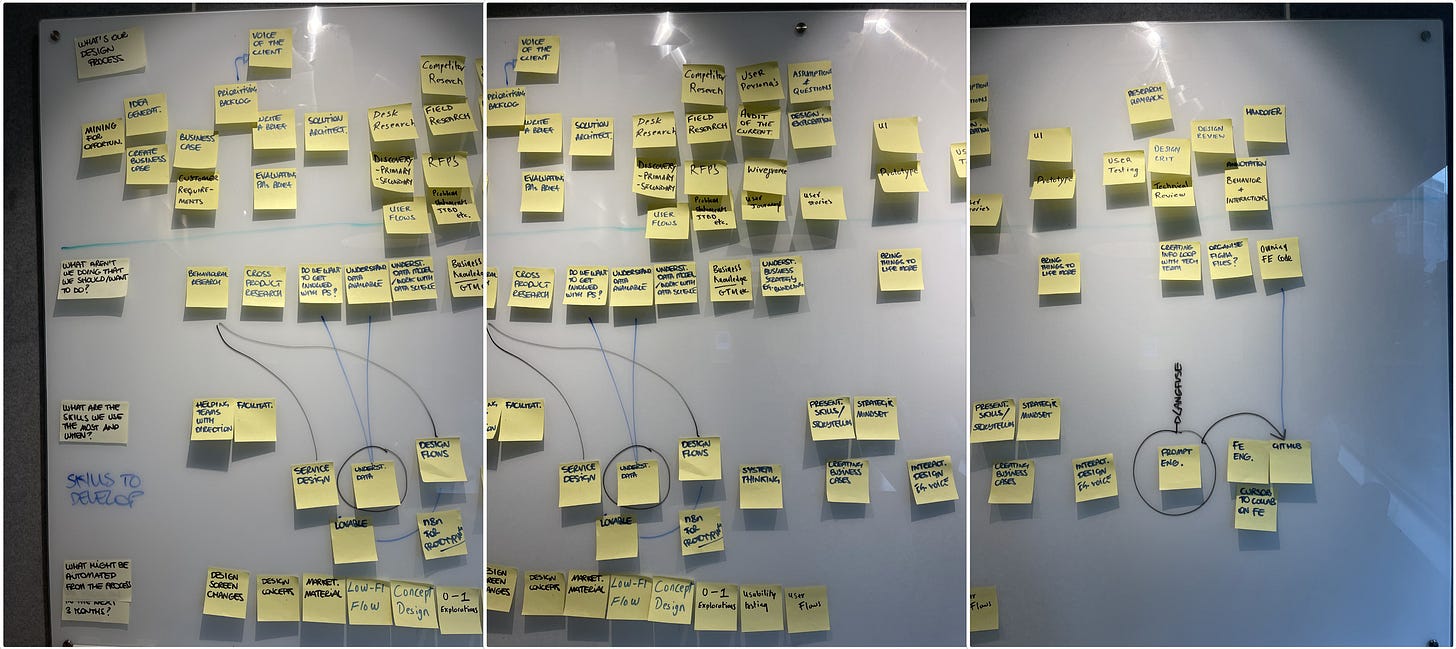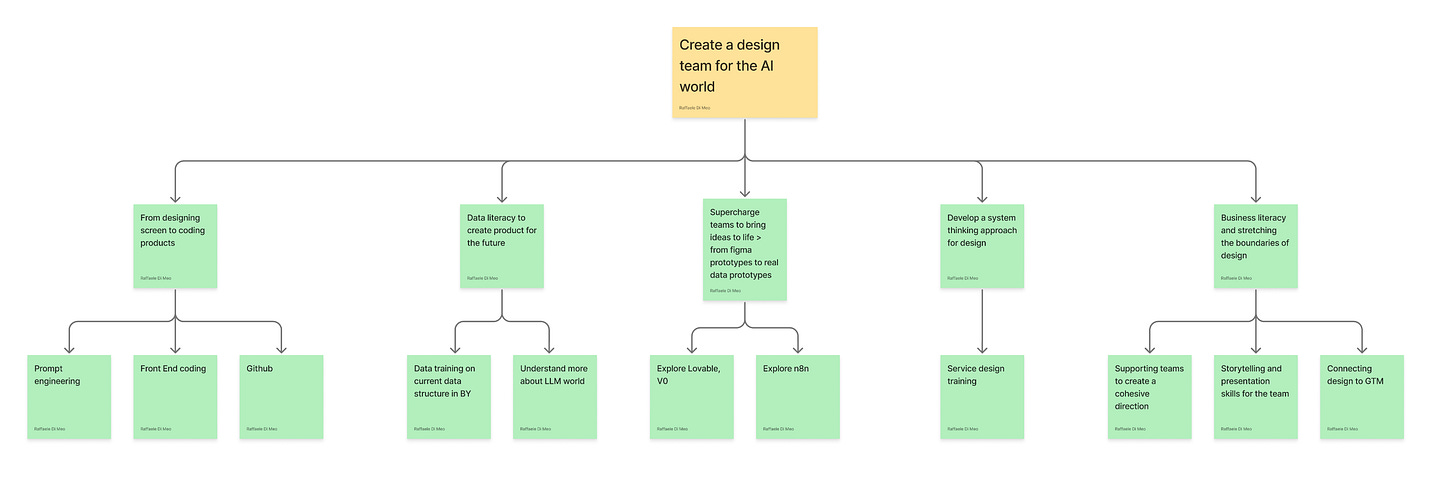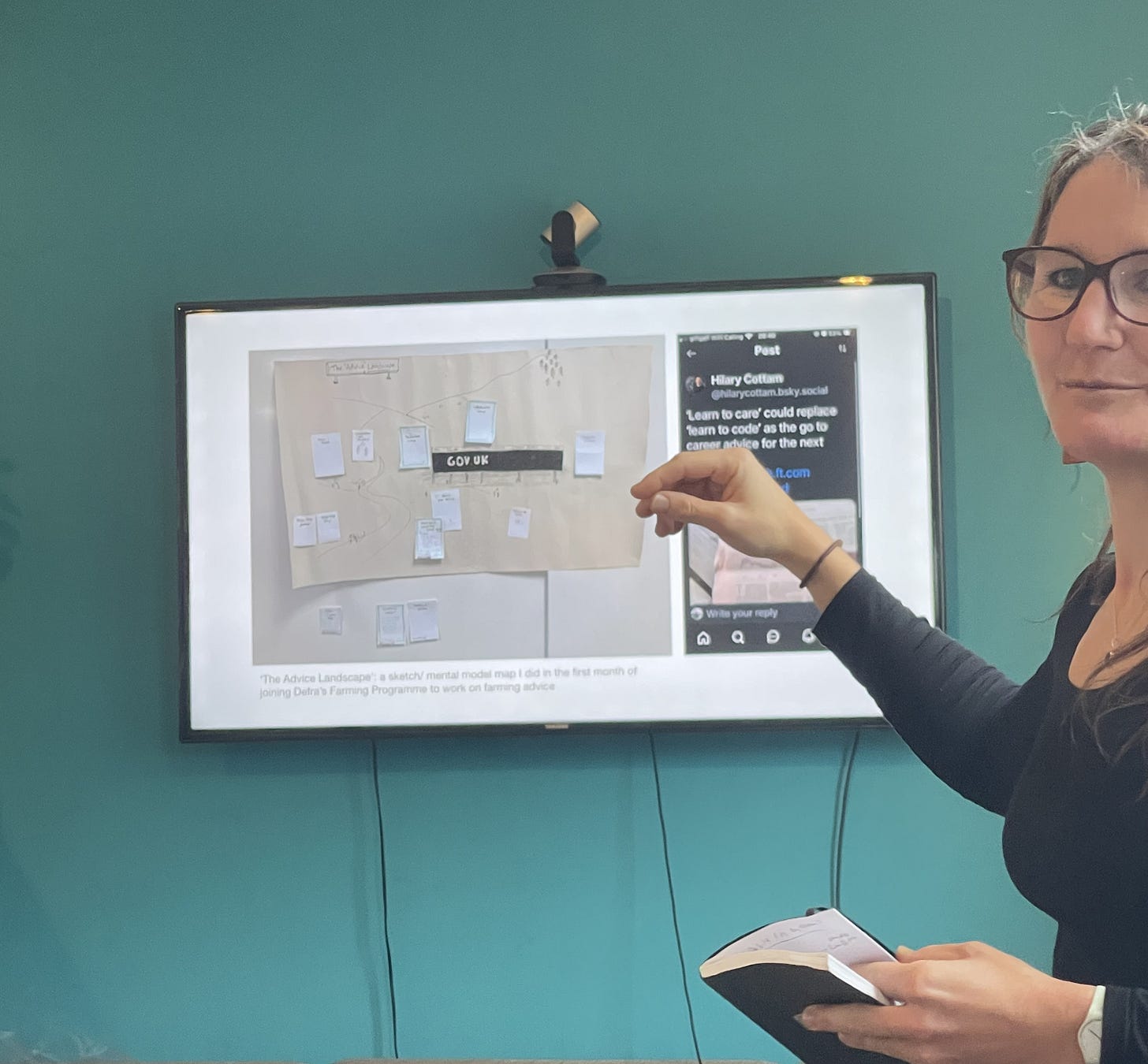
A few months ago, our design team hit pause to do something rare: reflect.
We spent a couple of days listening, discussing, and experimenting to understand what’s happening in the world of design, especially in the context of AI. We weren’t out to create a product or launch something shiny. Instead, the goal was simple:
What does it mean to be a design team in an AI-shaped world, and how should we evolve?
We wanted to explore the tools that are rapidly transforming the design landscape. Some of us experimented with tools like V0, Cursor, Figma Make, Lovable, and n8n, which weren’t new to most of us, and we could see how they could and would change the way we think about design.
But the tools were just a starting point. What mattered more was the question:
What can we do now that we couldn’t before, and what should we stop doing, start doing, or double down on?
I created a structured workshop for the entire team to address those questions and provide a space for everyone to share their feelings about the tools, AI's role in everything we do, job changes, and shifts in ways of working—a place for everyone to express how they felt.
At the same time, I wanted to make sure things didn’t feel too gloomy, which can easily happen when discussing AI… it’s taking our jobs!!! So, I also set a fun challenge for the team to design something solely with AI. It wasn’t anything directly related to our world, but it’s a way to reignite the creative spark that can sometimes get lost in daily work. That’s definitely a positive side of AI, for sure!
Mapping our process, re-evaluating our roles
We kicked off by mapping out our whole design process. From early discovery, research, and ideation, through to prototyping, user testing, and handoff. Every step, every role, every touchpoint.
Then we layered on:
- Tasks we want to do more of
- Tasks we no longer think add value
- Skills we currently lack but want to develop
- Activities that might soon be automated
This gave us a clear picture of where we are today and where we could go next. This is what we discovered.

1. Research needs a reboot
We work in the B2B sector, and we often work on new products from concept to launch. Also, we operate in the digital returns space, a relatively new area for retailers and logistics providers. As a result, return tasks are often spread across multiple roles (personas) rather than being assigned to a single person. This means we don't have direct access to many customers. Much of our current work depends on assumptions, hypothetical scenarios, or sales conversations (which are not always the most unbiased!). We lack robust behavioural insights from real users and environments. Therefore, a key priority for us is to deepen our behavioural and cross-product research and to explore where AI can help us accelerate or expand this work.
Spoiler alert: we have started working on an AI discovery agent to tackle this problem, and it’s exciting but also scary promising!
2. We need to design with the business, not just for users
This is nothing new, to be honest. It‘s something we have been discussing for a very long time. Designers need to learn business, they need to speak the language of the company, and they need to work closely with Marketing. But how are we actioning it?
It has been a few years since we started working more closely with the sales team, providing them with assistance on pitches, artwork, and educating them on the product and its rationale, enabling us to connect the dots more effectively. We have also participated in demos, using them as a way to get closer to clients, join their calls, and build a strong partnership. However, we haven’t come closer to Marketing as much. We also noticed that the Go To Market team plays a crucial role in the stage of creating a new product. It could be a great way to gauge the market and assess how our new products are perceived, tying the messaging and, if needed, the design work back in.
Understanding bundling strategies, customer segmentation, and launch priorities could radically improve how and what we design. That’s one of the shifts we've consciously decided to make as a team: start having more regular calls with our Product Marketing Manager.
Here are some links from a previous post with useful resources for business for designers.
3. New tools = new opportunities
A huge part of our discussion was around prototyping and front-end collaboration. With AI tools like V0, Lovable, Cursor, and Builder.io, we’re no longer limited to static wireframes. We can now:
- Build prototypes that behave like real products
- Move faster from idea to interaction
- Collaborate more deeply with developers
This means our role as designers is expanding. We’re moving beyond design systems.
Connect to check how we are becoming more AI savvy
4. Moving towards holistic design and systems thinking
There will be less and less need for complex UI, dashboards, and interactions. You will easily ask an AI agent to fetch data for you, compare it with previous charts, or even adjust settings and generate a report. This means you won’t need to navigate pages, open drop-down menus, or select dates on a calendar.
Fewer interfaces mean fewer elements to design.
Most interactions will happen within a chat, which will appear more static and require less UI. However, this does not mean that no designers are needed or that fewer designers are required, in my opinion.
We still need to consider how interactions occur, what follow-up questions to ask, and, most importantly, anticipate what information the user may need. We also need to create a model that delivers the correct information in the simplest way possible. This might still involve charts, graphs, or tables, which will require some design effort.
But the most critical aspect is understanding how the information is connected and integrated. That’s why I believe systems thinking will become more prominent, and ultimately, we will revisit what UX used to be, where flows were everywhere. In this context, the flow of information involves connecting with different APIs and data models.
Lenny’s chat with Aparna Chennapragada from Microsoft is quite eye-opening and gives a clear picture of what might be coming next for designers.
The skillsets we’re doubling down on

To support this shift, we’ve outlined five key capabilities we want to develop as a team:
1. Data Literacy
We’re shaping products around data models. That means understanding how data is structured, how LLMs work, and how we can influence the design of intelligent systems.
2. Business Literacy
Great design aligns with business goals. We aim to improve our storytelling, pitching, and alignment with commercial strategies—so design not only adds value but also demonstrates its worth.
3. Prototyping on steroids
Tools like Framer, AI-generated flows, or even no-code platforms give us the power to bring ideas to life quickly and convincingly, something that’s essential when collaborating cross-functionally.
4. Service Design
The future isn’t just about screens. It’s about orchestrating services, flows, and experiences. Understanding systems thinking helps us zoom out and design more holistically.
5. Engineering fluency
Whether it’s learning GitHub basics, diving into front-end tooling, or understanding prompt engineering, we want to reduce the friction between design and build.
Our North Star: Becoming a design team for the AI era
To summarise it all, our ambition is bigger than ever. It’s not just about having a design strategy and a few principles. It’s about changing Design on its head. We don’t want to react to the AI shift; we want to drive it forward, but in a way that is conscious, well thought out, and ethical for everyone involved. As part of the front team, we can be more in control and help the business understand what design can do and how it can facilitate effective decision-making.
This means:
- Moving from static screens to functional prototypes
- From design-to-handoff to design-to-deploy
- From siloed research to real-world insight
- From UI to system-level thinking
- From passive collaboration to business partnership
We’re just at the beginning of this journey, but it already feels exciting and urgent!
If you’re navigating similar questions in your team, I’d love to exchange ideas. Let’s shape what’s next for design, together.
Want to know more about our AI journey? Connect!
A few fun things from this month
I am going to Malaga next month for Wey Wey Web. It’s genuinely my favourite conference and I am running a workshop all about product mindset! If you want to join, you can grab 20% discount code with my code: P457N3RsC0d3
I attended a Service Design Breakfast in Brighton, organised by Clearleft, and the lovely Becky Miller helped us reflect on the value of designing for humans, not just users. This is a beautiful shot showing a quote I loved:
‘Learn to care’ could replace ‘Learn to code’

